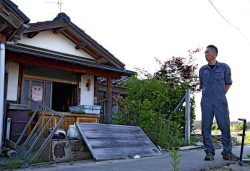Many Noto Peninsula Homes Lacked Seismic Retrofitting; Aging Population Slowed Pace of Expensive Renovations

Rescuers walk past destroyed houses in Suzu, Ishikawa Prefecture, on Thursday.
17:41 JST, January 5, 2024
Why was the damage from the New Year’s Day earthquake that hit the Noto region in Ishikawa Prefecture so extensive?
The scale of the earthquake exceeded the possibilities considered in prefectural government’s disaster management planning. The prefectural government had anticipated a magnitude 7.0 quake, but the magnitude of the latest one exceeded that, at 7.6.
The current assumptions for the extent of damage in the plan were formulated in fiscal 1997, and the prefecture was planning to complete the formulation of a revised plan in fiscal 2025 that would reflect the latest research results on seismic faults and social conditions, such as aging and population decline in the prefecture.
“The earthquake occurred just as we were working on the new plan, though we have taken some measures, such as revising assumptions on tsunami inundation after the [2011] Great East Japan Earthquake,” a prefectural government official lamented.
The low rate of seismic retrofitting work may have also contributed to the high degree of damage.
In the city of Suzu, Ishikawa Prefecture, which suffered devastating damage, only about 51% of the 5,886 houses in the city met earthquake resistance standards in fiscal 2018, far below the overall national percentage of 89% for the same period. According to the city, most of the houses in Suzu were wooden structures built before 1981, when the Building Standards Law was revised.
The aging of the population was a major factor that put the brakes on the seismic retrofitting of structures in the city. The percentage of the population aged 65 or older in the city was about 51% as of 2020, the highest of any municipality in the prefecture. “Since it costs at least ¥1 million for seismic retrofitting of a house, it is thought that owners were hesitant to make their homes earthquake-resistant, and also that old vacant houses were hit by the quake,” a municipal official said.
An earthquake swarm that has been occurring since the end of 2020 has also had an impact. In May last year, an earthquake measuring upper 6 on the Japanese seismic intensity scale of 7 occurred. In an emergency risk assessment to check the safety of damaged structures as of May 11 last year, 361 structures were classified as “dangerous” and 689 as “requiring caution.”
According to the city, some of the structures damaged in the latest earthquake had been classified as “dangerous,” and it is believed that damage from the previous earthquake had not been repaired in those structures.
“Areas suffering from an aging population and delays in seismic retrofitting work have a reduced ability to respond to disasters,” said Yoshiaki Kawata, director of the Research Center for Societal Safety Sciences of Kansai University and an expert on disaster mitigation. “The central and local governments need to consider and build a wide-area support system, including use of marine transportation, in anticipation of a massive earthquake such as the Great East Japan Earthquake and the latest earthquake.”
"Society" POPULAR ARTICLE
-

M4.9 Earthquake Hits Tokyo, Neighboring Prefectures
-

Israeli Tourists Refused Accommodation at Hotel in Japan’s Nagano Pref., Prompting Protest by Israeli Embassy and Probe by Prefecture
-

M7.5 Earthquake Hits Northern Japan; Tsunami Waves Observed in Hokkaido, Aomori and Iwate Prefectures
-

Tsukiji Market Urges Tourists to Avoid Visiting in Year-End
-

High School in Kyoto Says Students Shoplifted during Recent School Trip to Bali, Indonesia
JN ACCESS RANKING
-

Tokyo Economic Security Forum to Hold Inaugural Meeting Amid Tense Global Environment
-

Keidanren Chairman Yoshinobu Tsutsui Visits Kashiwazaki-Kariwa Nuclear Power Plant; Inspects New Emergency Safety System
-

Imports of Rare Earths from China Facing Delays, May Be Caused by Deterioration of Japan-China Relations
-

University of Tokyo Professor Discusses Japanese Economic Security in Interview Ahead of Forum
-

Japan Pulls out of Vietnam Nuclear Project, Complicating Hanoi’s Power Plans


























